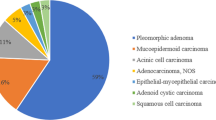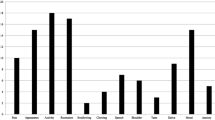Abstract
To evaluate the quality of life after surgery for benign neoplastic disease of the parotid gland. Forty-nine patients who underwent surgery for benign parotid disease between January 2004 and December 2008 were included in this retrospective study. EORTC QLQ-C30 and EORTC QLQ-H&N35 questionnaires were used to determine the quality of life. The variables of these questionnaires were compared with age, gender, educational status, histopathologic diagnosis and Frey syndrome. A statistically significant correlation was noted between the female gender and post-surgical pain, sleeplessness and the use of non-steroid anti-inflammatory drugs (p < 0.001). There was a significant difference between age and difficulties in moving the mouth (p < 0.001). Frey syndrome related to social functions, economical difficulties, speech defect, reduced sexuality, and nutritional parameters were found to be statistically significant (p < 0.001). Frey syndrome is the most common complication that affects the quality of life in patients who had parotidectomy due to a benign parotid disease. Therefore, all patients should be informed about Frey syndrome before parotidectomy.
Similar content being viewed by others
References
Smith SL, Komisar A (2007) Limited parotidectomy: the role of extracapsular dissection in parotid gland neoplasms. Laryngoscope 117:1163–1167
Erkan AN, Yavuz H, Ozer C, Ozer F, Ozluoglu L (2008) Quality of life after surgery for benign disease of the parotid gland. J Laryngol Otol 122:397–402
Aaronson NK, Ahmedzai S, Bergman B et al (1993) The European Organization for Research and Treatment of Cancer QLQ-C30: a quality of life instrument for use in international clinical trials in oncology. J Natl Cancer Inst 85:365–376
Bjordal K, Kaasa S (1992) Psychometric validation of the EORTC core quality of life questionnaire, 30 item version and a diagnosis-specific module for head and neck cancer patients. Acta Oncol 31:311–321
Bjordal K, Hammerlid E, Ahlner-Elmqvist M et al (1999) Quality of life in head and neck cancer patients: validation of the European Organization for Research and Treatment of Cancer Quality of Life Questionnaire-H&N35. J Clin Oncol 17:1008–1019
Bradley PJ (2004) Pleomorphic salivary adenoma of the parotid gland: which operation to perform? Curr Opin Otolaryngol Head Neck Surg 12:69–70
Marshall AH, Quraishi SM, Bradley PJ (2003) Patients’ perspectives on the short- and long-term outcomes following surgery for benign parotid neoplasms. J Laryngol Otol 117:624–629
McGurk M, Thomas BL, Renehan AG (2003) Extracapsular dissection for clinically benign parotid lumps: reduced morbidity without oncological compromise. Br J Cancer 89:1610–1613
Guntinas-Lichius O, Klussmann JP, Schroeder U, Quante G, Jungehuelsing M, Stennert E (2004) Primary parotid malignoma surgery in patients with normal preoperative facial nerve function: outcome and long term postoperative facial nerve function. Laryngoscope 114:949–956
Beutner D, Wittekindt C, Dinh S, Huttenbrink KB, Guntinas-Lichius O (2006) Impact of lateral parotidectomy for benign tumors on quality of life. Acta Otolaryngol 126:1091–1095
Gliklich RE, Goldsmith TA, Funk GF (1997) Are head and neck specific quality of life measures necessary? Head Neck 19:474–480
Sherman AC, Simonton S, Adams DC, Vural E, Owens B, Hanna E (2000) Assessing quality of life in patients with head and neck cancer: cross-validation of the European Organization for Research and Treatment of Cancer (EORTC) Quality of Life Head and Neck Module (QLQ-H&N35). Arch Otolaryngol Head Neck Surg 126:459–467
Ware JE Jr, Sherbourne CD (1992) The MOS 36-item short-form healt survey (SF-36). I. Conceptual framework and item selection. Med Care 30:473–483
Bova R, Saylor A, Coman WB (2004) Parotidectomy: review of treatment and outcomes. ANZ J Surg 74:563–568
Reilly J, Myssiorek D (2003) Facial nerve stimulation and postparotidectomy facial paresis. Otolaryngol Head Neck Surg 128:530–533
Gaillard C, Périé S, Susini B, St Guily JL (2005) Facial nerve dysfunction after parotidectomy: the role of local factors. Laryngoscope 115:287–291
Mehle ME, Kraus DH, Wood BG et al (1993) Facial nerve morbidity following parotid surgery for benign disease: the Cleveland Clinic Foundation experience. Laryngoscope 103:386–388
Patel N, Har-El G, Rosenfeld R (2001) Quality of life after great auricular nerve sacrifice during parotidectomy. Arch Otolaryngol Head Neck Surg 127:884–888
de Bree R, van der Waal I, Leemans CR (2007) Management of Frey syndrome. Head Neck 29:773–778
Casler JD, Conley J (1991) Sternocleidomastoid muscle transfer and superficial musculoaponeurotic system plication in the prevention of Frey’s syndrome. Laryngoscope 101:95–100
Singleton GT, Cassisi NJ (1980) Frey’s syndrome: incidence related to skin flap thickness in parotidectomy. Laryngoscope 90:1636–1639
Wallis KA, Gibson T (1978) Gustatory sweating following parotidectomy: correction by a fascia lata graft. Br J Plast Surg 31:68–71
Laskawi R, Schott T, Mirzaie-Petri M, Schroeder M (1996) Surgical management of pleomorphic adenomas of the parotid gland: a follow-up study of three methods. J Oral Maxillofac Surg 54:1176–1179
Tugnoli V, Marchese Ragona R, Eleopra R, De Grandis D, Montecucco C (2001) Treatment of Frey syndrome with botulinum toxin type F. Arch Otolaryngol Head Neck Surg 127:339–340
Cavanaugh K, Park A (1999) Postparotidectomy fistula: a different treatment for an old problem. Int J Pediatr Otorhinolaryngol 47:265–268
Nitzan D, Kronenberg J, Horowitz Z, Wolf M, Bedrin L, Chaushu G (2004) Quality of life following parotidectomy for malignant and benign disease. Plast Reconstr Surg 114:1060–1067
Acknowledgments
No financial support was received for this paper.
Conflict of Interests
The author(s) declare that they have no competing interests.
Author information
Authors and Affiliations
Corresponding author
Rights and permissions
About this article
Cite this article
Gunsoy, B., Vuralkan, E., Sonbay, N.D. et al. Quality of Life Following Surgical Treatment of Benign Parotid Disease. Indian J Otolaryngol Head Neck Surg 65 (Suppl 1), 105–111 (2013). https://doi.org/10.1007/s12070-012-0585-7
Received:
Accepted:
Published:
Issue Date:
DOI: https://doi.org/10.1007/s12070-012-0585-7




